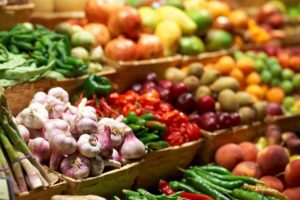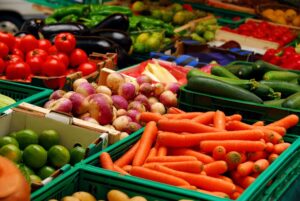
Exports of agricultural products in December 2023 should exceed 6 million tons, which became possible due to the opening of the Ukrainian shipping route, said Maksym Kharchenko, analyst at UkrAgroConsult, an information and analytical agency.
“Exports of agricultural products in December 1-15 totaled 3.38 million tons, which is 20% more than in the same period of the previous month. At the same time, the share of land exports in total exports decreased to 14.1% amid increased activity of seaports. At the same time, the role of the Danube ports in the first half of December was the lowest for the whole of 2023,” he said.
According to him, the rate of exports of agricultural products by road decreased by the end of the year due to the continuation of strikes in neighboring European countries. Currently, a queue of almost 4,000 trucks has formed to enter Ukraine from Poland. The Ministry of Infrastructure of Ukraine says that by the end of this year, Ukraine and Poland may come to a common position on blocking the borders.
“It should be noted that vegetable oils remain the main commodity transported by road for export,” UkrAgroConsult said.
Speaking about the export of agricultural products by rail, analysts noted that its pace in the first weeks of December is only slightly behind the pace of previous months. The total export volume in December is forecast at 800-900 thousand tons, which does not differ from the average for the last four months. Export flows by rail have not yet had time to reorient towards seaports.
UkrAgroConsult reported that as of December 19, 6.6 thousand railcars with grain (or about 400 thousand tons) were heading to Ukrainian seaports via domestic rail transportation, which is almost a thousand more than a week earlier.
At the same time, exports by sea through the ports of the Danube region in the first half of December amounted to only 0.56 million tons, which is far behind the same period last month.
“The Danube region is gradually losing its attractiveness for exporters due to the opening of a much cheaper option for exporting through Odesa ports,” analysts explained.
Partly due to the activity of the ports in the Danube region, in January-November, the Romanian port of Constanta shipped 32.6 million tons of grain, setting a record (the previous annual record was just over 25 million tons). Ukrainian grain amounted to 13 mln tons, or about 40% of the total transshipment volume. In 2022, the volume of transshipped agricultural products from Ukraine in the port of Constanza amounted to 8.6 million tons, UkrAgroConsult stated.

“Kernel, one of Ukraine’s largest agricultural holdings, has been using its Aeneid and Mavka vessels to export agricultural products for the second year in a row and intends to further expand its fleet, the agricultural holding reported on Facebook.
“For the second year, we have been operating our own vessels and transporting Ukrainian products in the difficult conditions of the termination of the grain deal. (…) Two Kernel vessels, Aeneid and Mavka, are currently exporting Ukrainian products. The deadweight (maximum loading) of the bulk carrier Aeneid is 47,335 tons, and the Mavka tanker is 13,500 tons. We have no plans to stop and are already working on expanding the fleet,” the statement said.
The agricultural holding noted that the use of its own fleet is economically beneficial, especially during the period of inflated freight rates during martial law. The development of its own shipping gives impetus to the entire market and strengthens the country’s export capabilities, Kernel believes.
“The Black Sea remains the only alternative for Ukrainian exports. The deep-water ports are able to accumulate and ship large-tonnage consignments of more than 60 thousand tons. This makes it possible to optimize logistics processes and significantly reduce costs. All alternative routes have extremely high logistics costs,” the agricultural holding explained and promised to continue to strengthen Ukraine’s exports and contribute to food stability in Europe and the world.
As reported, before the war, Kernel was the world’s largest producer of sunflower oil (about 7% of global production) and its exports (about 12%). It is one of the largest producers and sellers of bottled oil in Ukraine. In addition, it is engaged in the cultivation and sale of agricultural products.
In the first quarter of FY2024, the company posted a net loss of $30.9 million, while the previous year ended with a net profit of $162 million, with a 17% decrease in revenue to $564 million.
According to the report, the book value per share for the year decreased from $20.7 to $6 (or PLN26.22), in particular due to an increase in the number of shares from 77.429 million to 147.864 million.

In 2023, Ukraine became the third largest supplier of agricultural products to the EU and increased its share of agricultural imports by 11% in January-September compared to 2022, the Polish publication farmer.pl reported, citing a report by the European Commission.
“Ukraine remains one of the three largest suppliers of agricultural products to the EU, according to the European Commission’s report on international trade. In the period from January to September this year, the European Union increased imports of agricultural products from Ukraine by 11% compared to 2022,” the publication wrote.
According to the report, the value of Ukrainian exports of agricultural products to the EU in the period from January to September 2023 reached EUR8.75 billion.
“Imports from Ukraine showed the largest increase in the period from January to September compared to 2022 (+891 million euros, or +11%), mainly due to an increase in grain imports,” the European Commission report says.
The biggest jump in these imports was recorded between January and June this year. Since June, imports have remained below the level of 2022, and in September they almost returned to the level of 2021, the EC said.
According to the results of the reporting period, Ukraine became the third largest exporter of agricultural products to the EU – after Brazil and the UK.
At the same time, Ukraine ranks 14th among the recipients of agricultural products from the European Union. From January to September of this year, Ukraine imported products from the EU for EUR 2.5 billion, which is 19% more than in the same period last year, farmer.pl noted.

In October 2023, Ukraine managed to export 4.8 million tons of agricultural products, up 15% from the same period of the previous month, the Ukrainian Agribusiness Club reported on Facebook.
According to the report, the increase in exports in October 2023 was achieved despite problems with routes through the Danube river ports – traditional seasonal shallow water, which prevents the entry of larger vessels, and a decrease in the load on barges.
“Part of the increase in exports was due to the addition of another export channel – the seaports of Odesa region, which are currently operating as part of a temporary sea corridor. However, the volume of exports through this channel is very far from pre-war levels,” the analysts stated.
According to their information, in October 2023, Ukraine exported 2.5 mln tonnes of grains, 52% of which were wheat and 45% were corn, which showed a 20% increase compared to the previous month. Oilseeds were exported to 914.0 thsd tonnes (rapeseed – 48%, soybeans – 48% and sunflower seeds – 3%), up 4%.
In addition, exports of vegetable oils increased by 6% to 508.7 thousand tons (sunflower oil – 80%, rapeseed oil – 14%, and soybean oil – 6%), and by 18% of cake – 491.5 thousand tons (sunflower oil – 86%, soybean oil – 14%).
Exports of corn and soybeans, which are currently being actively harvested, increased compared to the previous month.
“Although there has been an increase in exports, they remain insufficient to export the harvest that Ukraine has harvested this year. For the relatively normal functioning of the agricultural market, Ukraine needs to export about 6 million tons of food per month, preferably by sea, where logistics are less expensive,” the UCAB summarized.

Three bulk carriers with agricultural products and iron ore have left the ports of Chornomorsk and Pivdennyi, and five new vessels are heading to the ports for loading, said Deputy Prime Minister and Head of the Ministry of Reconstruction Oleksandr Kubrakov.
“Bulk carriers AZARA, YING HAO 01, ENEIDA (flags of Liberia and Palau) exported more than 127 thousand tons of Ukrainian agricultural products and iron ore,” he wrote on Facebook on Sunday.
According to the Deputy Prime Minister, 5 new vessels are being loaded at the ports of Greater Odesa: bulk carriers OLGA, IDA, DANNY BOY, FORZA DORIA, NEW LEGACY export almost 120 thousand tons of Ukrainian grain to Africa and Europe.